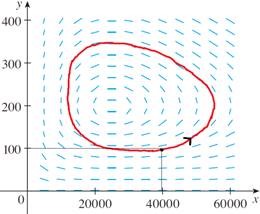
Concept explainers
a.
that which variable represents bird population or insect population
a.
Answer to Problem 22RE
Explanation of Solution
Given information : The question is
Population of birds and insects are modeled by equation
Calculation :
In the absence of species
Absence of species
After substituting
Then
In the absence of species
Absence of species
After substituting
Then
Therefore,
b.
To find : an equilibrium solution and explain their significance
b.
Answer to Problem 22RE
The equilibrium solutions are
Explanation of Solution
Given information : The question is
Population of birds and insects are modeled by equation
Calculation : The equilibrium solution is the set of values of
c.
To find : an expression for
c.
Answer to Problem 22RE
The expression
Explanation of Solution
Given information : The question is
Population of birds and insects are modeled by equation
Calculation :
From the chain rule
d.
To use : the phase trajectory to describe how both population change
d.
Explanation of Solution
Given information : The question is
Population of birds and insects are modeled by equation
The phase trajectory, corresponding to the initial condition
To draw the phase trajectory use direction field

The arrow indicates that as
Chapter 7 Solutions
Single Variable Calculus: Concepts and Contexts, Enhanced Edition
 Calculus: Early TranscendentalsCalculusISBN:9781285741550Author:James StewartPublisher:Cengage Learning
Calculus: Early TranscendentalsCalculusISBN:9781285741550Author:James StewartPublisher:Cengage Learning Thomas' Calculus (14th Edition)CalculusISBN:9780134438986Author:Joel R. Hass, Christopher E. Heil, Maurice D. WeirPublisher:PEARSON
Thomas' Calculus (14th Edition)CalculusISBN:9780134438986Author:Joel R. Hass, Christopher E. Heil, Maurice D. WeirPublisher:PEARSON Calculus: Early Transcendentals (3rd Edition)CalculusISBN:9780134763644Author:William L. Briggs, Lyle Cochran, Bernard Gillett, Eric SchulzPublisher:PEARSON
Calculus: Early Transcendentals (3rd Edition)CalculusISBN:9780134763644Author:William L. Briggs, Lyle Cochran, Bernard Gillett, Eric SchulzPublisher:PEARSON Calculus: Early TranscendentalsCalculusISBN:9781319050740Author:Jon Rogawski, Colin Adams, Robert FranzosaPublisher:W. H. Freeman
Calculus: Early TranscendentalsCalculusISBN:9781319050740Author:Jon Rogawski, Colin Adams, Robert FranzosaPublisher:W. H. Freeman
 Calculus: Early Transcendental FunctionsCalculusISBN:9781337552516Author:Ron Larson, Bruce H. EdwardsPublisher:Cengage Learning
Calculus: Early Transcendental FunctionsCalculusISBN:9781337552516Author:Ron Larson, Bruce H. EdwardsPublisher:Cengage Learning





